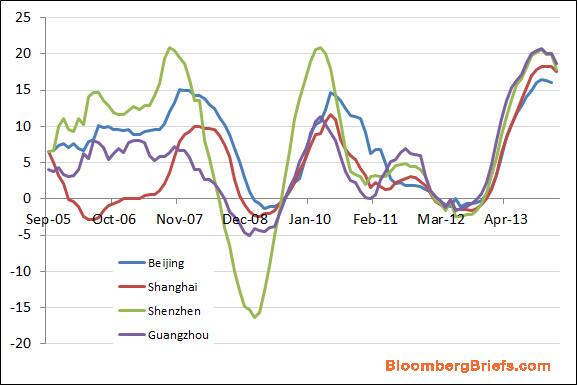
I noted last night that steel and iron ore futures took a hammering but it looks like I misread yesterday’s house price release, which showed material month on month deceleration. Zero Hedge has sell-side analysis:
From BofAML:
Prices of new commodity homes for 70 medium-to-large-sized cities surveyed by the National Bureau of Statistics (NBS) increased by 0.40% mom in January, same as in December. In yoy terms, average price growth of the 70 cities dropped to 9.5% in Janaury from 9.7% in December.
The number of cities with higher mom home prices was 62 in January, down from 65 in December; while the number of cities with falling mom home prices rose to six in January from two in December. Soufun’s 100-city average new home price index painted a similar picture, with mom growth easing to 0.63% in January from 0.70% in December.
And SocGen:
China’s January housing price inflation largely unchanged from the previous month for new apartments but softened notably in the second-hand market. Together with the news of loan curbs on the sector, China’s equity market reacted negatively and fell by more than 2%, as property and related stocks led the decline.
…The deceleration was led by first-tier and upper-second-tier cities. Notably, Beijing reported the first decline in second-hand property prices (-0.1%mom) since June 2012, and Shanghai had the lowest second-hand home price inflation since May 2012.
Easing housing inflation serves as another sign that housing demand is cooling off, which argues against further strengthening of construction activity. On top of that, bank lending to the real estate sector seems to have started tightening up, as a number of commercial banks have reportedly suspended lending to developers. The development supports our view that the property market will contribute to investment growth deceleration in 2014.
…In 2013, China had 10% increase in new home prices and 20% growth (floor space) in new home sales. We don’t expect that trend to be sustained. In 2014, we expect average yoy national home price growth to slow to low single digit on tapering pent-up demand and higher housing supply. We also see an growing diversification among cities as urbanization and migrangration create both winners and losers.
Slowing or even falling home prices in some cities can create volatity in fixed asset investment and financial markets, but we think a one-way rise of home prices could be even more negative for China as it invites too much speculation.
This is forming the backdrop to the building iron ore and steel shakeout.

